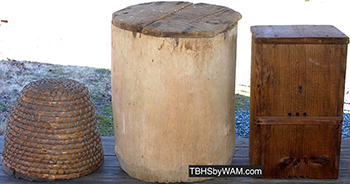
When I learned beekeeping history as a kid, the subject was really only a summary mentioning just three hives: a skep, a log hive, and a box hive (see Figure 1). The skep, a tightly woven basket, was used in various forms in the Old World. It fell out of favor in America, perhaps partly because of the super abundance of wood in the east.
The log hive is often made from black gum trees because it frequently forms a hollow as the tree ages. By sectioning the dead tree, thinning its sides, the volume of the hive becomes larger and its weight lighter. In regional slang, even the hive’s name got shaved down to just “gum.” Many times, I have heard old frame-hive beekeepers, their early days rooted to a rural life, call their beehives bee gums or just gums.
And finally there is the box hive, also known as a plank hive. It was merely a wooden box, usually taller than wide, sometimes built square, and always open at the bottom (like the other hives). The box hive in Figure 1 has a set of upper entrances with an alighting board, both rarities. Usually a box hive has about a half dozen notches cut into its lower edge for entrances (the same for the gum). The old entrances were tiny compared to the standard modern size. But the old entrances kept the mice out.
The honey harvest with these hives was deadly. The instructions were as ancient as the skeps themselves. In the fall, select the heaviest skeps, which have the most honey, and the lightest skeps, colonies destined to starve. So take their honey now. Over a small pit of burning brimstone (sulfur), place the skep. With the opening of the pit a close match to the bottom of the skep, put loose dirt around the bottom edge of the hive to seal off the connection even better. All the bees suffer a horrible death in mere minutes. The honeycombs are cut out, and the empty skeps will be needed for the next swarm season. With skeps, not only are swarms desired to rebuild low hive numbers, but early swarming is a premium because they have a greater chance of winter survival.
During the 1800’s in Europe and the United States of America, hive development began incorporating ways to avoid killing bees when removing honey. These hives began appearing well before Reverend Langstroth’s hive with movable frames based on the bee space. In America the history of these hives is not well known, and certainly not known from primary (original) sources and from actual hives. In this article we begin to glimpse some of that history, including the crucial gaps in the record.
Figures 2 and 3 show a rare secretarial copy of the patent agreement concerning the first beehive patent granted in the United States from 1810. (I cannot find any beehive patents that are older.) A secretarial copy is a copy of an original document. During this time in history, copies had to be written out in longhand. So ironically, this document is an original copy, a very old and rare one.
Rather than specifying the technical details of the beehive improvement(s), which would be in the patent itself, this patent agreement states that John Sweet, the patentee, has fulfilled the obligations to secure his beehive patent. For example, the document certifies that he paid the fee ($30), and that his claimed beehive improvement(s) were new. Next came some legal arrangements.
In a most revealing manner, the document concludes with not only the patent date, but another date, a reminder of the blood, death, and sacrifice that gave birth to our Country (see Figure 4), and which I cite here:
“… Given under my hand at the City of Washington this eleventh day of April in the year of our Lord one thousand eight hundred & ten and of the Independance [sic] of the United States of America the Thirty fourth [.]”
Does the signature look familiar? “James Madison,” fourth President of the United States (1809-17). He was one of the Founding Fathers of our Country. Of course that is not his actual signature, rather a secretarial copy of his signature. Nevertheless – from a collection of apicultural documents, who would expect to find even an old copy of a presidential signature? From a Founding Father no less. Now for my long-enduring mystery.
I study the design of old beehives, including their subtle nuances that speak of the original intent of their inventors. In my paper hardcopy files, are almost 1,000 beehives that I have never seen – the very first one granted to John Sweet in 1810. Before the internet, I hunted through microfilm for Sweet’s patent. I knew the patent would be written out in ….


